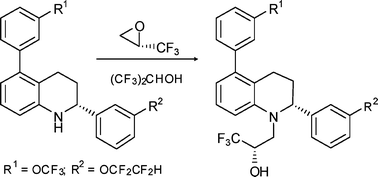Regio- and diastereoselective ring-opening of (S)-(−)-2-(trifluoromethyl)oxirane with chiral 2,5-disubstituted tetrahydroquinolines in hexafluoro-2-propanol
Abstract
Multi-hundred grams of

* Corresponding authors
a
Johnson & Johnson Pharmaceutical Research & Development, L.L.C., Welsh & McKean Roads, P. O. Box 776, Spring House, Pennsylvania, USA
E-mail:
xli6@its.jnj.com
Fax: +1 (215) 540-4611
Tel: +1 (215) 628-7829
b Johnson & Johnson Pharmaceutical Research and Development, a Division of Janssen Pharmaceutical, API Development, Turnhoutseweg 30, Beerse, Belgium
Multi-hundred grams of

 Please wait while we load your content...
Something went wrong. Try again?
Please wait while we load your content...
Something went wrong. Try again?
X. Li, R. K. Russell, H. Chen, Y. Zhang, S. Ballentine, J. Spink, S. Branum, F. Liu, Y. Chen, T. Rammeloo, W. Aelterman, K. L. Sorgi and W. V. Murray, Green Chem., 2010, 12, 1548 DOI: 10.1039/C004726K
To request permission to reproduce material from this article, please go to the Copyright Clearance Center request page.
If you are an author contributing to an RSC publication, you do not need to request permission provided correct acknowledgement is given.
If you are the author of this article, you do not need to request permission to reproduce figures and diagrams provided correct acknowledgement is given. If you want to reproduce the whole article in a third-party publication (excluding your thesis/dissertation for which permission is not required) please go to the Copyright Clearance Center request page.
Read more about how to correctly acknowledge RSC content.
 Fetching data from CrossRef.
Fetching data from CrossRef.
This may take some time to load.
Loading related content
